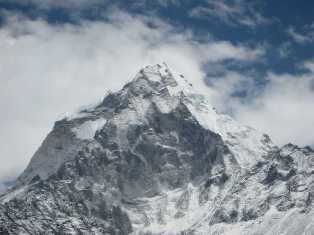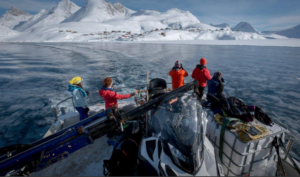Mt.Everest:A living laboratory

– By Michael Evans —
Mount Everest is not normally regarded as a living laboratory, but while geographers and outdoor enthusiasts worldwide are eagerly looking forward to May 2013 and the 60th anniversary of the first successful ascent, scientists will be using the mountain for a completely different purpose.
It was in 1856 that the Great Trigonometric Survey of India established that what was then known as Peak XV was the world’s highest mountain. In 1856 it was given the English name of Mount Everest in honour of Sir George Everest, former British General Surveyor of India.
The mountain is situated on the border between Nepal and Tibet and since both countries were closed to foreigners in the 1850s, the British had no idea that in Tibet the mountain is known as Chomolungma, or Mother of the Universe, while to the Nepalese it is Sagarmatha, or Goddess of the Sky.
The first serious attempts to climb the mountain were in the 1920s, but it was not until 1953 that the ninth British expedition was successful, when New Zealander Edmund Hillary accompanied by a Nepalese sherpa Tenzing Norgay, reached the summit on 29th May.
Since then there have been many successful climbs to the summit. The total has now reached well over 5,000 and this includes a number by what could be classed as the older generation. Edmund Hillary and Tensing Norgay were, respectively, 33 and 39 years old when they reached the top, but in recent years nearly half of all the climbers have been over 40, with one in 30 of them being over 60.
Of course older people are a good deal healthier than they were 50 years ago and the decline in smoking has made a big contribution to this. Guided expeditions are now available and many older people now have sufficient disposable income to finance this sort of trip.
However, expeditions of this sort are not without their risks, particularly for the older generation. The overall chance of dying on a mountain has been put at 1.5%, but for climbers over 60 this has been put at 5%. Between 1922 and 2010 Everest claimed 219 lives and recovery of bodies above 26,000 feet is so difficult that most corpses have been left where they fell, with a result that some are clearly visible from standard climbing routes.
The height of Everest is given as 29,035 feet and altitudes above 26,246 feet (8,000 metres) are known as the “death zone”. Here there are significant challenges to survival.
Temperatures can drop to very low levels, causing frostbite to any body part exposed to the air. Atmospheric air pressure at these high altitudes is only about a third of the pressure at sea level and this reduces the availability of oxygen by about a third.
Debilitating effects of the extreme cold and lack of oxygen can cause most climbers to take up to 12 hours to walk the final 2.75 miles from the South Col to the summit. Even this can only be achieved after a long period of acclimatisation. Without this, a sea-level dweller would probably lose consciousness within two to three minutes.
Of course these sorts of activities are a personal challenge, but they are also a natural source of research for conditions such as heart disease, lung problems, muscle loss, sleeping disorders and new medical technologies. Climbers are put under the same conditions and experience very much the same symptoms as those suffering from heart disease, obesity or advanced age.
As part of a study programme, from mid-April to Mid-May researchers from the Mayo Clinic are to join an expedition to Everest where they will monitor nine climbers for the duration of their climb.
The leader of the scientific expedition is physiologist Dr Bruce Johnson. He has already conducted research at the South Pole and other mountain ranges and this time he said that they will be studying the effects of extreme altitude on healthy, active individuals because what they experience mimics aspects of heart disease.
Other projects will include sleep physiology. At 18,000 it is hard to get a good night’s sleep. Researchers will study sleep quality as it relates to high altitude problems, coupled with lack of oxygen.
Previous studies have shown that climbers rapidly lose weight at high altitudes and that this is due to muscle wasting and not loss of fat. This is a common problem with many chronic diseases such as heart disease and the hypothesis is that this weight loss is due to severe lack of oxygen, particularly at night. This is a further area of study by the team.
Fluid in the lungs is common among heart patients and it is sometimes found among climbers at high altitudes, but not all climbers, so there might be other factors causing this. Researchers will be looking at the pressures on lungs and other factors such as gas transfer across the lungs.
It has been said that on Everest youth and vigour will always trump age and experience, but in this case it is youth and vigour who will be providing a vital research platform to help to safeguard the health of those of an older generation. – Earthtimes














